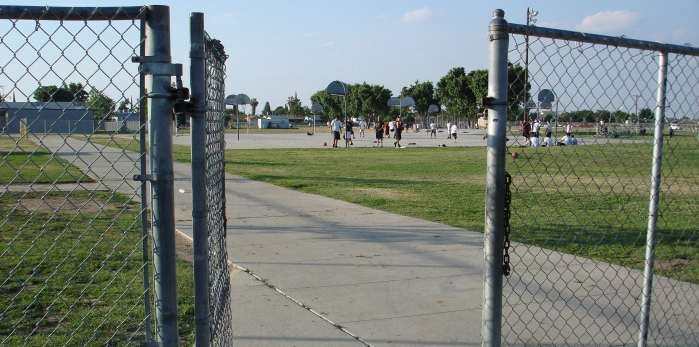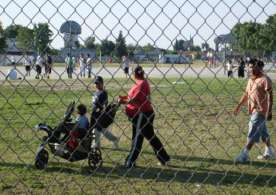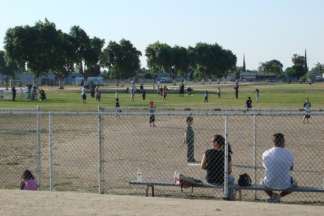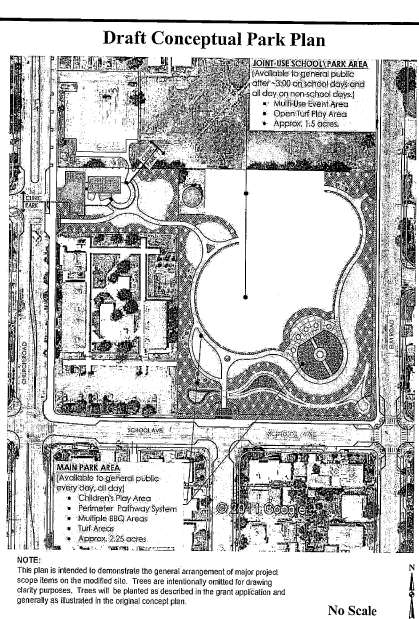Share On Social!
After years of trying to land a new park, residents of Earlimart, Calif., can now celebrate the success of a shared use agreement and soon-to-be-built 4-acre park. Residents living in the small rural community of Earlimart, Calif., lacked outdoor spaces for the physical activity they needed to develop and maintain healthy lifestyles and weights. The Earlimart School District’s superintendent responded to this need by trying an experiment. She had the custodial staff at one school leave the school gate open. Word got around that the school’s gate had been left open—soon the school’s field was filled with local residents. This experiment ultimately led to a change in the school district’s policy, which allows Tulare county residents from non-affiliated groups to use the school yard at Earlimart Middle School. The story does not end here; once residents realized the difference a place to play could make in improving the health of the community, they sought to get a new park, too, and they succeeded. As an added bonus, a much-needed health clinic will also be constructed on the site where the park will be built, making healthcare services more accessible.
EMERGENCE
Awareness: Individuals working with The Central California Regional Obesity Prevention Program (CCROPP), California Project LEAN, and the Earlimart School District realized that more needed to be done to address the lack of physical activity environments in Tulare County.

Traditionally, lifestyle interventions had focused on individual behavioral change. However, these programs alone had not addressed the lack of play space in Earlimart.
Earlimart, a small, rural town with a population of about 8,500 residents, is one of Tulare County’s most impoverished communities.
Latinos make up close to 89% of Earlimart’s population and according to the California Department of Education childhood obesity rates in Tulare were higher than the state average (34% vs. 31.2%). Additionally, 77.4% of adolescents living in Tulare were not receiving the recommended 60 minutes a day of physical activity.
Learn: Pixley, another rural community in Tulare County situated just 6 miles from Earlimart, had just enacted a shared use agreement allowing children to use a school’s indoor facilities during after school hours. If a shared use agreement had worked well in Pixley, why couldn’t it work in Earlimart?
This was the question that went through the mind of Susan Elizabeth, a community partner with CCROPP and independent consultant for Capacity Builders, Inc.

Elizabeth had already helped establish a shared use agreement in Pixley and was actively involved in bringing healthy changes to Earlimart.
Having worked in Earlimart for some time, Elizabeth knew that the residents there did not have a park and now could be time to change this.
To learn more about shared use agreements, Elizabeth found and studied material from ChangeLab Solutions on the Internet. She would later seek more guidance by speaking directly with individuals from ChangeLab Solutions.
Elizabeth found out that many schools do allow affiliated community organizations to use their facilities, but non-affiliated groups often get left out of the picture.

“Affiliated groups like the Y or a local church are covered by liability insurance when they as a group use the facility,” Elizabeth said. “It’s the non-affiliated groups that we’re concerned about—these are just folks within the community. They are just there because they live around there.”
Elizabeth also learned of the California Civic Center Act, which not only promotes the use of every school as a place of recreation for the community, but also lessens liability when the gates of a school are left open.
Frame Issue: After having learned about the California Civic Center Act, Elizabeth believed the best thing to do at Earlimart was to embed the shared use of the school’s yard into the school’s wellness policy, thus covering affiliated groups and the community. According to Elizabeth: “Most of the schools in California have underutilized space. In other words they have much more land than they actually use.”
Elizabeth knew that most schools in California had two fences. There was the perimeter fence around the entire school property and the facility fence which fences off just the school.
Because funding for parks and places of recreation can often be pricey, communities (especially rural communities like Earlimart) should be able to turn to schools as a place that they can use as a park, Elizabeth thought.
“Why not look at that space which the school has, with the possibility of making it into something that communities can use?” Elizabeth said.
DEVELOPMENT
Education: At first, Sandra Muñoz, then-superintendent for Earlimart, was reluctant to even consider the idea of opening school grounds to the public. However, as she learned more about the issue from Elizabeth and from others, her perspective seemed to change.
“It was probably Pixley…and just a general awareness that changed her mind,” Elizabeth said of the superintendent’s decision to leave the gates at Earlimart Middle School open. “I think she got it and I was very open about what I was doing. I kept feeding her information. She got invited to meetings. She talked to colleagues.”
Mobilization: The school experimented first with leaving its outer gate open. Word got around that the gate was left open. So people just started showing up and using the schoolyard.
The goal would now be to make this agreement official via inclusion into the district’s wellness policy.

Debate: The idea that healthy children makes better students is one that educators and school administrators can understand. According to Elizabeth, this was one reason that the superintendent decided to take a risk and leave the schoolyard open to the public.
The school yard had been open to the community for about a year. By the time formal shared use agreement language was formally proposed to be added into the school wellness policy, it was difficult for the school board to turn down the idea.
Although, many were satisfied with having access to the school play yard, others felt newer spaces, such as a park, were needed for physical activity.
ENACTMENT
Activation: Elizabeth applied for and received a $20,000 mini-grant offered by California Project Lean as part of their efforts to establish shared use practices in areas of great need.
California Project LEAN is a collaboration of the California Department of Public Health and the Public Health Institute that focuses on policy and environmental change strategies to reduce the prevalence of obesity and chronic diseases.
Jane Alvarado, a project coordinator with Project Lean, and Clint Lara, food services director of the Earlimart School District, were working to bring healthy changes to the district’s cafeteria by removing flavored milk from the school’s cafeteria and making clean drinking water available.
The healthy food efforts of Alvarado and Lara “might have helped build the momentum that had already been started,” Alvarado said.
Elizabeth, who also sat on the district’s wellness council, met with Alvarado, Lara, and other members of the council—including parents and school board members—to recommend adding language about the shared use of school recreational property to the district’s wellness policy.
While local residents used the Earlimart Middle School playground as an unofficial park, Elizabeth and members from the wellness council worked to ensure that the playground would remain open to the community during non-school hours, by writing it into the district’s wellness policy.
In addition, community advocates also voiced their desire for an entirely new park.
They had noticed a 4-acre empty lot situated next to Earlimart Elementary School that seemed like the perfect place to build a park.
“So that site was there, but it wasn’t [considered] until the community asked, ‘Why can’t we make a park on that space, where the carnival comes every year?” Elizabeth said. “And that came actually from the people in the community.”
Elizabeth pulled together a multi-disciplinary team of local officials to see what could be done to build a park on this piece of land.
The superintendent agreed to host regular meetings with county resource management agency staff, elected officials, and other community advocates to discuss how to proceed.
Through these meetings Elizabeth and the team of community partners learned of a state grant which could provide funds to construct a new park if the school district agreed to enter into a shared use agreement with Tulare County.
Frame Policy: For help with laying down some of the legal groundwork for the new park, Elizabeth again turned to resources from ChangeLab Solutions.
“I knew nothing about how to develop parks, so a lot of the initial work was developing strategies about how to move forward,” Susan said. “Then I started to need some legal input. I didn’t know who else I could ask who would have the same level of legal and planning expertise.”
Elizabeth and the team of county officials discussed how to create the Earlimart Neighborhood Park. They thought one third of the park should be open to the community during the school day, and that the remaining two thirds should be opened after school. Because Earlimart is prone to flooding, planners decided to request that a drainage area be created. A local hospital district decided to provide funds for the construction of a clinic on a portion of the land.
So far, the experiment of shared usage of Earlimart Middle’s schoolyard was a success. Maintenance costs had not doubled, as had been feared, and there were no issues with liability or vandalism of school property.
The shared use language could call for “the gates to be open from dawn to dusk, when school is not happening,” Elizabeth said. “So that’s what the push is for us now.”
Change: The wellness council agreed to include a provision on shared use of the district’s facilities in the district’s wellness policy. The policy is a living document and open for revision for whenever the wellness committee sees fit, although the district’s school board must vote on changes.
After members of the wellness council revised and approved the wellness policy, it was taken to the district’s school board, which approved it May 17, 2011.
Meanwhile, to fulfill the requirements for the state grant, county officials and board members from the Earlimart School District created a shared use agreement for the future site of the Earlimart Neighborhood Park.
On June 21, 2011, the County entered into a Joint Powers Agreement (shared use agreement) with the Earlimart School District, according to a document from the Tulare County Resource Management Agency. The agreement stated that, upon receiving grant funds for construction of the neighborhood park, that shared use of the grounds would be in effect for the next 30 years.

The $2.2 million in funds to develop The Earlimart Neighborhood Park next to Earlimart Elementary were awarded on March 26, 2012, through the California State Parks Office of Grants and Local Services (OGALS).
Later that year, the County of Tulare Resource Management Agency conducted a study and prepared a negative declaration, to report that the new park would not significantly impact the environment.
Air quality assessments were conducted by the San Joaquin Valley Air Pollution Control District and a biologist, Robert Hansen, conducted a field survey to determine if any endangered or protected species exist at the site of the proposed park.
On January 29, 2013, the board of supervisors from The County of Tulare Resources Management Agency approved the environmental documents after a public hearing.
Additional plans for the new park continue to be developed.
IMPLEMENTATION
Implementation: Although the school yard at Earlimart Middle was already being used informally by the community at the time it was written into the school’s wellness policy, the district sent home a letter to parents to inform them of all the healthy changes coming to the Earlimart School District through the revised wellness policy.
Plans for the construction of the Earlimart Neighborhood Park are currently in progress.
According to a January 29, 2013, agenda of the County of Tulare Resource Management Agency:
The new park will be constructed on about 4.5 acres of district-owned property at 949 E. School Ave and deliverables include:
a. A new pathway system and picnic facilities;
b. New multi-use event area;
c. New children’s play area;
d. New open turf play area;
e. New gateway features, community art and security fencing; and
f. New drought resistant landscaping and biofiltration swale.
The agenda also states that “construction must be completed by December 31, 2018, and thereafter the State will review the Final Grant Completion Packet, conduct a final site inspection, and process final payments through the State Controller’s Office before June 30, 2019.”
“It’s a multiple use park which is a very exciting prospect for this town,” Elizabeth said.
Equity: The shared use of Earlimart Middle School’s property as a town park and the development of the Earlimart Neighborhood Park are filling a gap in access to spaces for physical activity that has existed in Earlimart for more than 50 years.
Since Earlimart school district updated their wellness policy to include shared use language, a new track was added to school property, too, combining with the impending neighborhood park to provide many additional spaces for play.
Sustainability: The Center for Disease Control and Prevention (CDC) will evaluate the impact the new park has on the community to determine the most effective strategies to promote good health, according to a CDC document from.
Additional Links:
For more resources on how to create shared use agreements, visit the ChangeLabSolutions webpage.
This success story was produced by Salud America! with support from the Robert Wood Johnson Foundation.
The stories are intended for educational and informative purposes. References to specific policymakers, individuals, schools, policies, or companies have been included solely to advance these purposes and do not constitute an endorsement, sponsorship, or recommendation. Stories are based on and told by real community members and are the opinions and views of the individuals whose stories are told. Organization and activities described were not supported by Salud America! or the Robert Wood Johnson Foundation and do not necessarily represent the views of Salud America! or the Robert Wood Johnson Foundation.
ABOUT THE PROGRAM
Salud America! The RWJF Research Network to Prevent Obesity Among Latino Children is a national program of the Robert Wood Johnson Foundation. The program aims to educate researchers, decision-makers, community leaders, and the public in contributing toward healthier Latino communities and seeking environmental and policy solutions to the epidemic of Latino childhood obesity. The network is directed by the Institute for Health Promotion Research at the University of Texas Health Science Center at San Antonio.
For more information, visit http://www.salud-america.org.
By The Numbers
84
percent
of Latino parents support public funding for afterschool programs
This success story was produced by Salud America! with support from the Robert Wood Johnson Foundation.
The stories are intended for educational and informative purposes. References to specific policymakers, individuals, schools, policies, or companies have been included solely to advance these purposes and do not constitute an endorsement, sponsorship, or recommendation. Stories are based on and told by real community members and are the opinions and views of the individuals whose stories are told. Organization and activities described were not supported by Salud America! or the Robert Wood Johnson Foundation and do not necessarily represent the views of Salud America! or the Robert Wood Johnson Foundation.



